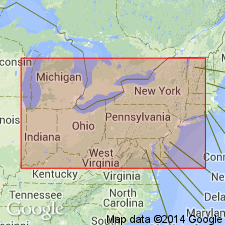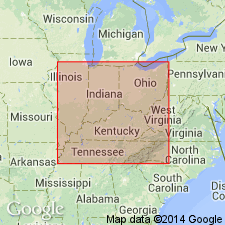
- Usage in publication:
-
- Little Rock Creek limestone
- Modifications:
-
- Named
- Dominant lithology:
-
- Limestone
- AAPG geologic province:
-
- Cincinnati arch
Summary:
Name Little Rock Creek limestone proposed for the gray brittle conchoidally fracturing limestone above the Logansport near Lockport, Carroll Co., northwestern IN. Fauna includes a large CHONETES. Thickness 7 ft. Age is Devonian.
Source: GNU records (USGS DDS-6; Reston GNULEX).

- Usage in publication:
-
- Little Rock Creek Dolomite
- Modifications:
-
- Redescribed
- Dominant lithology:
-
- Dolomite
- AAPG geologic province:
-
- Cincinnati arch
Summary:
Unit referred to as Dolomite rather than Limestone. In Delphi area, northern IN, is a correlative of the Blocher Member of the Olentangy Shale of the New Albany Group. Bone bed 14 occurs at base. Underlies Selmier Member of Olentangy and associated bone bed 15. Age is Late Devonian.
Source: GNU records (USGS DDS-6; Reston GNULEX).
For more information, please contact Nancy Stamm, Geologic Names Committee Secretary.
Asterisk (*) indicates published by U.S. Geological Survey authors.
"No current usage" (†) implies that a name has been abandoned or has fallen into disuse. Former usage and, if known, replacement name given in parentheses ( ).
Slash (/) indicates name conflicts with nomenclatural guidelines (CSN, 1933; ACSN, 1961, 1970; NACSN, 1983, 2005, 2021). May be explained within brackets ([ ]).

